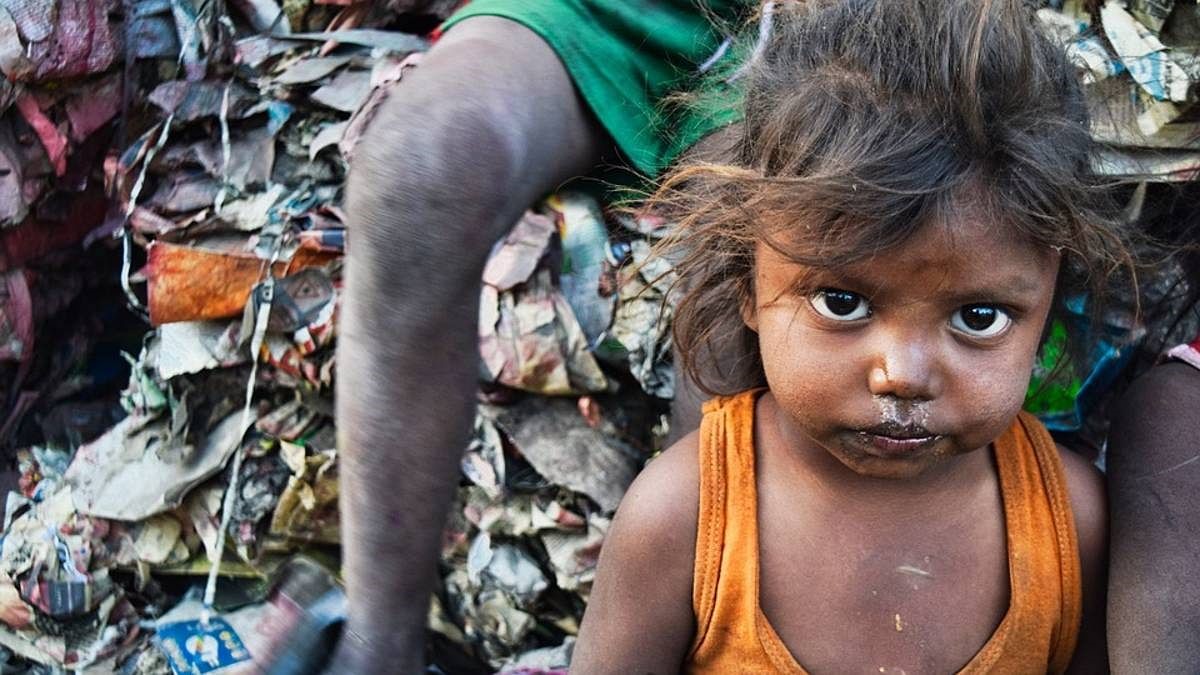Description

Disclaimer: Copyright infringement not intended.
Context
- The Indian government, in its Interim Budget speech, declared a significant milestone in poverty alleviation, asserting that 25 crore Indians have been lifted out of poverty over the past decade.
- This assertion is rooted in a discussion paper titled "Multidimensional Poverty in India Since 2005-06," released by NITI Aayog on January 15, authored by Ramesh Chand and Yogesh Suri.
Details
- The government's claim is substantiated by the decline in multidimensional poverty from 29.17% in 2013-14 to 11.28% in 2022-23.
- The paper highlights that approximately 24.82 crore people escaped poverty during this period, with states like Uttar Pradesh, Bihar, and Madhya Pradesh leading the way.
Multidimensional Poverty Index (MPI)
- Traditionally, poverty assessment relies on income or expenditure levels.
- However, the MPI introduces a paradigm shift by utilizing indicators covering health, education, and standard of living.
- These dimensions, each carrying one-third weight in the index, include indicators such as nutrition, child & adolescent mortality, years of schooling, and household-specific factors.
Calculation of MPI:
- Incidence of Multidimensional Poverty (H): The proportion of multidimensionally poor individuals in the population.
- Intensity of Poverty (A): The average proportion of deprivation experienced by multidimensionally poor individuals.
- MPI Value: Obtained by multiplying the incidence (H) and intensity (A), providing a comprehensive measure of multidimensional poverty.
Data for 2013-14 and 2022-23:
- The health metrics crucial for MPI calculations rely on data from the National Family Health Survey (NFHS), conducted every five years.
- To bridge the gap between NFHS rounds, the paper utilizes interpolation for 2013-14 and extrapolation for 2022-23.
Significance and Implications:
- Policy Impact: The assessment aligns with the government's 'Sabka ka Saath' initiative, showcasing tangible results in poverty reduction.
- State-Level Dynamics: The state-wise data reveals regional variations in poverty reduction efforts, emphasizing the need for tailored policies.
- Paradigm Shift: The MPI, with its focus on health, education, and living standards, provides a holistic approach to poverty assessment, offering a nuanced understanding beyond income metrics.
.jpg)
Global Multidimensional Poverty Index (MPI) 2023
- The index is a crucial international tool measuring acute multidimensional poverty across 100+ developing countries.
- Launched in 2010 by OPHI and the Human Development Report Office of the UNDP.
- Monitors deprivations in 10 indicators covering health, education, and standard of living, considering both incidence and intensity of poverty.
- A person is considered multidimensionally poor if deprived in one-third or more of the weighted indicators. Extreme multidimensional poverty is applicable for those deprived in half or more of the weighted indicators.
Key Highlights:
- Global Overview:
- Acute multidimensional poverty is observed in 1.1 billion people globally, constituting 18% of the total population in 110 countries.
- Sub-Saharan Africa has 534 million poor, and South Asia has 389 million, together hosting five out of every six poor people.
- Half of MPI-poor people (566 million) are children under 18, with a poverty rate of 27.7% among children and 13.4% among adults.
- India's Status:
- India has more than 230 million people living in poverty.
- Around 18.7% of India's population falls under the category of vulnerability, indicating deprivations in 20-33.3% of all weighted indicators.
- India's Progress:
- India is among 25 countries, including Cambodia, China, Congo, Honduras, Indonesia, Morocco, Serbia, and Vietnam, that successfully halved their global MPI values within 15 years.
- Between 2005-06 and 2019-21, 415 million Indians escaped poverty.
- Incidence of poverty in India reduced significantly from 55.1% in 2005/2006 to 16.4% in 2019/2021.
- The number of multidimensionally poor individuals in India decreased from about 645 million in 2005/2006 to 230 million in 2019/2021.
- Improvement in Deprivation Indicators:
- India showed progress in health, education, and standard of living indicators.
- Poverty reduction was consistent across regions and socio-economic groups.
- The poorest states and groups, including children and disadvantaged caste groups, witnessed the fastest absolute progress.
- Deprivation in nutrition decreased from 44.3% in 2005/2006 to 11.8% in 2019/2021, and child mortality fell from 4.5% to 1.5%.
Evolution of Poverty Measurement in India
- Uniform Resource Period (URP) - Pre-1993-94:
- Before 1993-94, the poverty line in India was determined using the Uniform Resource Period (URP) method.
- This approach involved surveying individuals about their consumption expenditure over a 30-day recall period.
- The information gathered was based on people's recollection of their spending in the preceding month.
- However, this method had limitations, and there was a recognized need for a more comprehensive and accurate approach.
- Mixed Reference Period (MRP) - 1999-2000 Onwards:
- From 1999-2000 onwards, the National Sample Survey Organization (NSSO) transitioned to the Mixed Reference Period (MRP) method for poverty estimation.
- This method aimed to enhance precision by employing different reference periods for the assessment of various consumption items.
- For instance, individuals were asked about the consumption of specific items over the previous year, such as clothing, footwear, durables, education, and institutional health expenditure.
- For all other items, the reference period was the previous 30 days.
- Pre-Independence Poverty Estimation:
- Even before India gained independence, there were early attempts to estimate poverty.
- Dadabhai Naoroji, through his book "Poverty and Unbritish Rule in India," made one of the earliest estimations of the poverty line, ranging from ₹16 to ₹35 per capita per year.
- This estimation was based on the cost of a subsistence or minimum basic diet, including items like rice or flour, dal, mutton, vegetables, ghee, vegetable oil, and salt.
- The National Planning Committee in 1938 proposed a poverty line ranging from ₹15 to ₹20 per capita per month, focusing on ensuring an adequate standard of living.
- Post-Independence Poverty Estimation: After independence, various committees and groups contributed to the evolution of poverty estimation methods.
- Planning Commission Expert Group (1962): Introduced separate poverty lines for rural and urban areas (₹20 and ₹25 per capita per year, respectively).
- VM Dandekar and N Rath (1971): Advocated for a poverty line derived from the expenditure adequate to provide 2250 calories per day, moving away from subsistence living criteria.
- Alagh Committee (1979): Task force constituted by the Planning Commission adjusted poverty estimates for inflation, calculating poverty lines based on nutritional requirements.
- Lakdawala Committee (1993): Introduced state-specific poverty lines and discontinued scaling based on National Accounts Statistics.
- Tendulkar Committee (2009): Shifted from calorie consumption to a broader set of items and introduced a uniform poverty line basket. The committee adjusted for private expenditures and recommended a new method of updating poverty lines.
- Rangarajan Committee (2014):
- The Rangarajan Committee, formed against the backdrop of public outrage over the Planning Commission's suggested poverty line, aimed to review international poverty estimation methods and link poverty estimates to government schemes.
- The committee recommended a poverty line based on normative and behavioral levels, considering both adequate nutrition and general consumption patterns.
- Poverty Line (2011-12): ₹32 per day in villages and ₹47 per day in cities.
- Estimated that the number of poor was 19% higher in rural areas and 41% more in urban areas than the Tendulkar committee formula.
- International Poverty Line: Internationally, organizations like the World Bank define extreme poverty as living on less than $1.90 international dollars a day. The Asian Development Bank also has its poverty line, currently set at $1.51 per person per day.

Conclusion
In conclusion, the shift towards the MPI in assessing poverty reflects a more comprehensive and inclusive approach. The significant reduction in multidimensional poverty underscores the impact of targeted initiatives and sets the stage for informed policy interventions.
The evolution of poverty measurement in India reflects a transition from simplistic methods like URP to more nuanced approaches like MRP, incorporating diverse criteria from caloric intake to broader consumption patterns. The trajectory showcases a continuous effort to refine assessments, ensuring relevance to the socio-economic landscape and aligning with international benchmarks.
MUST READ ARTICLES:
https://www.iasgyan.in/daily-current-affairs/national-multidimensional-poverty-index-a-progress-review-2023
https://www.iasgyan.in/daily-current-affairs/poverty-in-india
https://www.iasgyan.in/daily-current-affairs/poverty-in-india-4#:~:text=Extreme%20poverty%20(less%20than%20Purchasing,in%20the%20last%20three%20years.
|
PRACTICE QUESTION
Q. Examine the multidimensional aspects of poverty in India with a focus on the findings of the Global Multidimensional Poverty Index (MPI) 2023. (250 Words)
|














